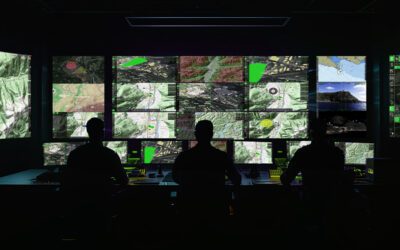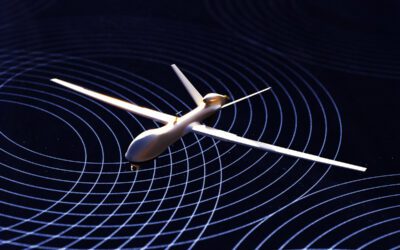While the success of any mission is a critical consideration, the safety of the aircraft and, most importantly, the crew must be paramount. Helicopter safety for both civilian and military operators has become far more reliable over the years, thanks to advances in vertical aviation safety criteria, the standard of equipment used, and a more proactive approach to maintenance and repairs. The development of advanced diagnostic tools can detect problems before they reach a critical level. At the same time, crew training has come a very long way from the early days of vertical aviation.
In this article, we’ll take a look at how helicopter safety can be improved through advanced avionics and real-time situational awareness. We’ll give you an overview of the current state of vertical aviation safety and how modern technology, including AR and AI, can help improve safety records in both the civilian and military sectors. We’ll also take a closer look at the role of real-time situational awareness, how pilot training has developed in recent years, and the advent of autonomous, uncrewed vehicles for more hazardous missions. We will also introduce the FlySight OPENSIGHT system and explain its key role in the safe operation of vertical platforms in the 21st century.
How helicopter safety has developed in the last 20 years
The past two decades have represented a major shift in helicopter safety, driven by advances in avionics, health and usage monitoring systems (HUMS), training and – more recently – the advent of AR and AI technology. A greater understanding of how systems integrate and what they can do to improve the safety of both civilian and military aircraft has led to much safer working conditions. Even when not strictly mandated, operators have been encouraged to upgrade their systems regardless, to drive both vertical aviation safety and mission success forward.
Safety will always be a challenge in vertical flight. Helicopters are incredibly complex systems, relying totally on the smooth operation of every single part of the machine, right down to the smallest bolt or the thinnest wire. Failure at any junction can lead to catastrophic consequences, including loss of the vehicle and even loss of life. Safety is a particularly challenging consideration in military operations, especially those carried out in hostile environments.
For civilian operators, operating in urban environments entails specific risks, including ground effect, overhead power cables, and unpredictable terrain. For Search & Rescue (SAR) teams, operating in difficult weather conditions, at sea, or in mountainous areas presents serious hazards to both the crew and the vehicle.
Looking at the whole picture
When it comes to vertical aviation safety, it’s not a matter of focusing purely on one area, such as engineering advancements, software development, or operational techniques. Safety is a sum of many parts, from the ground maintenance crews to the pilots and crew, command centre operatives, and all the way back to the vehicle and component design teams. Every step of the process has to interlink with every other element to create a whole and a symbiotic relationship between technology and human input.
Safety from both an engineering and software tools perspective ensures that this happens flawlessly, including installing operating systems that help reduce operator workload, integrating engineering processes and diagnostic technology to help maintenance teams work more efficiently, and pre-empting potential issues before they occur. The key consideration for helicopter safety in the 21st century is foresight, not hindsight. And that can now be achieved with far greater accuracy, thanks to tremendous technological advances.
Getting ahead of the problem with IoT
One of the key advancements in helicopter safety in recent years has been a shift from reactive to predictive maintenance. The advent of advanced sensors and real-time monitoring systems, especially those fitted with IoT sensors, is changing the way both civilian and military maintenance teams work. IoT sensors can help to predict potential mechanical failures long before they occur by analysing the data gathered during the vehicle’s operation.
Continuous collection and analysis, often utilising AI alongside human assessors to sift through the data, can monitor conditions both within the vehicle and environmental factors such as temperature, visibility, and atmospheric pressure, all of which can have a considerable impact on the safe operation of a vertical platform. From engine and drivetrain health to monitoring factors that contribute to crew workload and fatigue, connected sensor systems are among the key game changers in modern helicopter safety.
How can modern avionics technology improve the safety of helicopters?
So far, we’ve looked at the broader range of influences that are driving helicopter safety. However, if we bore down a little, there are specific systems and avionics technology that are playing a big part in providing crews with a safer working environment.
Collision avoidance systems – essential to maintaining helicopter safety. They are designed to help prevent not just collisions with other airborne vehicles, but also terrain collisions and issues with overhead power lines. They deliver this through real-time alerts and provide evasive guidance to the pilot.
The most advanced of these systems include HTAWS (Helicopter Terrain Awareness and Warning System) and, on some platforms, TCAS II (Traffic Alert and Collision Avoidance System). When combined with multi-layer augmented mapping such as FlySight’s OPENSIGHT system, these tools can significantly reduce collision risk and help lower CFIT risk.
Real-time health monitoring of engines – The worst-case scenario for any helicopter unit is an engine failure. These catastrophic events can be mitigated or avoided through a system of real-time engine health monitoring that sends up-to-the-second data to control crews, who can spot issues before they affect the aircraft. The pilot can then execute a safe landing. An additional safety feature added in recent years is crash-resistant fuel systems designed to limit fuel leakage and reduce the likelihood of fuel-line ruptures on impact, thereby lowering the risk of post-crash fire and explosion
Real-time engine monitoring also allows maintenance crews to carry out far more targeted repairs, as they have a greater understanding of the engine’s foibles and operating issues, which can then be repaired before the next mission.
Automated flight and navigation controls – We have already established that modern helicopters are incredibly complex vehicles, and their pilots are some of the most highly trained and skilled aeronauts in the skies. Any system that can take pressure off the operator is welcome, which is why automated flight and navigational controls are playing a major role in advancing helicopter safety. Consoles that provide additional information without overwhelming the user are also a part of this, where multi-layered information presented clearly and concisely can also take the pressure off the operators.
Autonomous uncrewed drones for dangerous missions – Military operations in hostile environments and reconnaissance operations in SAR scenarios are extremely hazardous. In an increasing number of cases, autonomous, uncrewed drones are taking over the role of the ‘eye in the sky’ and, in certain military situations, serving as strike platforms, removing any physical threat to the pilots and crews of human-crewed vehicles.
The role of real-time situational awareness and advanced pilot training
Situational awareness features give operators a better understanding of their environment, enabling better obstacle avoidance, more time for safe flying, and improved visual displays of essential avionics metrics. Situational awareness is a fundamental element of helicopter safety. When combined with advanced operator and pilot training technology, it leads to a greater skill set without burdening the operator with ‘too much information’.
The use of augmented and virtual reality simulations for operator training enables pilots to learn best-practice techniques with less training time and to better communicate with ground support teams.
There are, naturally, some challenges with advanced avionics and real-time situational awareness, primarily in integrating and interoperating new software with legacy systems. However, this issue is being overcome by developing consoles that provide all the real-time data required to improve situational awareness, while being easily compatible and integrated with existing hardware.
The use of familiar technology dramatically reduces the time required to learn and absorb advanced technology, which in turn helps cut costs and allows operators to redirect resources into other areas of helicopter safety.
What next? How FLYSIGHT is leading the way in vertical aviation safety technology
As well as greater use of uncrewed drones, aviation safety is also bound to focus on integrating AI and AR into onboard systems. At the forefront of this is OPENSIGHT Mission Console, representing the next generation of AR flight technology for helicopters. The turnkey consoles, along with customisable plug-ins, allow operators to create safer, more efficient working conditions. From dehazing technology that gives pilots better visual clarity in poor conditions to multi-spectral mapping that can aid in collision avoidance, OPENSIGHT demonstrates what can be achieved when bespoke technology is introduced into legacy systems.
You can find out more about FlySight’s OPENSIGHT system by browsing our informative videos and brochures. Or you can contact us in confidence to discuss your needs with one of our team, who will be happy to help with any queries on deployment and the operational value of customised console systems. Contact us today.




